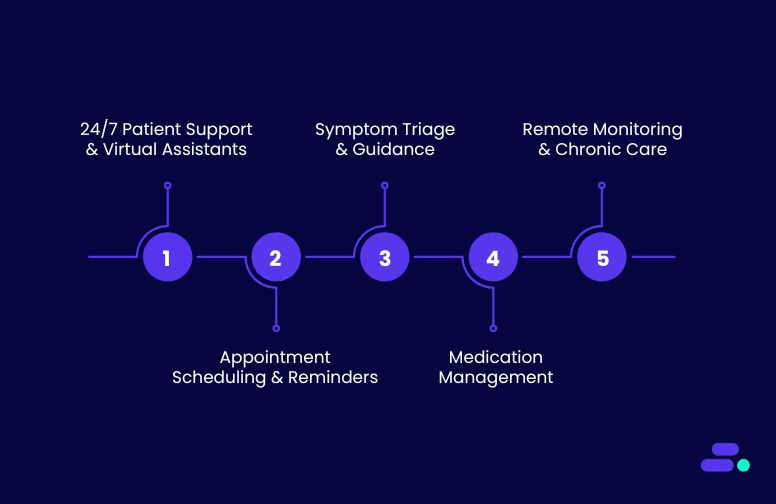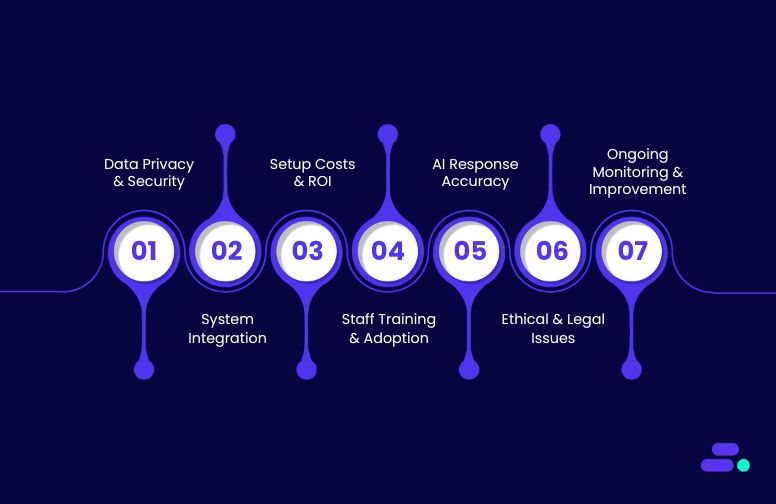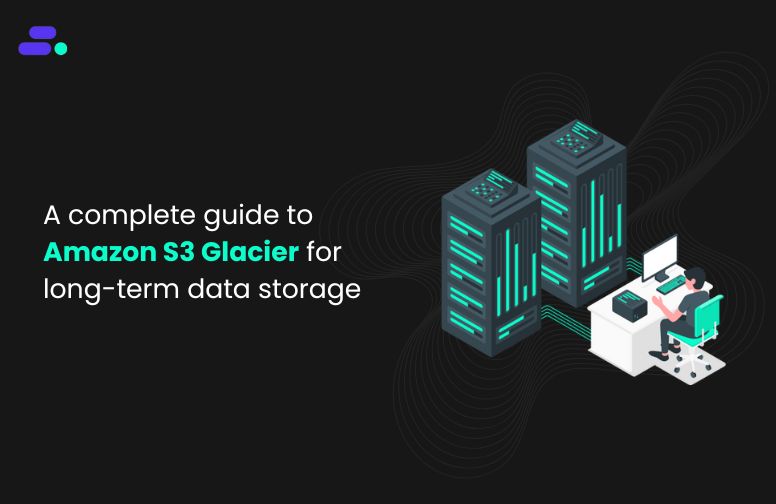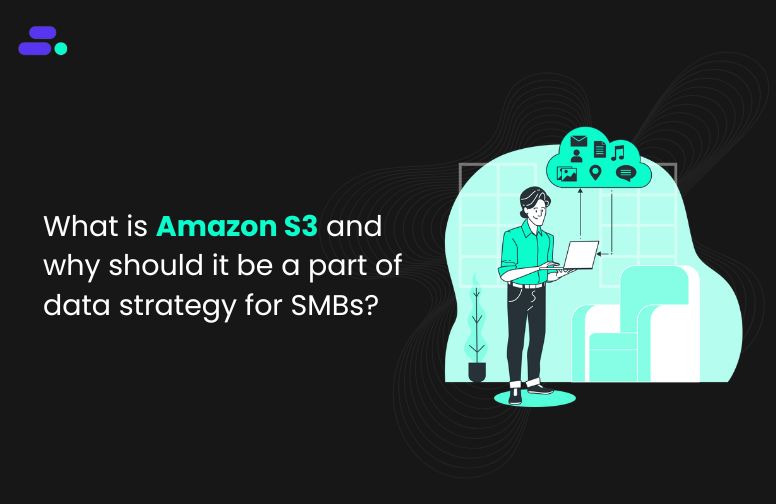This is a div block with a Webflow interaction that will be triggered when the heading is in the view.

Modernize your cloud. Maximize business impact.
Many SMBs juggle workflows through a patchwork of email chains, manual updates, and one-off scripts. It works, until a single link breaks, and the entire process grinds to a halt.
Consider a hospital’s critical lab test workflow. A single delay in collecting samples, processing results, or notifying the physician can mean hours lost in starting treatment. In emergencies, that lag could make the difference between recovery and deterioration. Managing these handoffs manually is like passing a baton in a dark room, someone’s bound to drop it.
AWS offers a smarter way forward: workflow orchestration using services like AWS Step Functions, EventBridge, and Lambda. These tools let SMB healthcare providers automate multi-step processes across labs, EHR systems, and care teams, ensuring results are processed, recorded, and communicated instantly. Workflows adapt to urgent cases, trigger follow-up actions, and scale without adding staff workload.
This article dives into how SMBs are using AWS workflow orchestration to simplify operations, reduce errors, and respond faster, turning complex processes into seamless, click-and-run efficiency.
Key takeaways:
- Automation eliminates manual delays and errors, enabling faster and more reliable workflows.
- AWS orchestration integrates diverse apps and systems, ensuring seamless data flow and coordination.
- Scalable workflows adjust automatically to changing demands, supporting business growth smoothly.
- Built-in monitoring provides clear visibility into workflow health, enabling proactive optimization.
- Working with experts like Cloudtech ensures workflows are designed and managed for lasting success.
How does AWS workflow orchestration help SMBs function smarter?

Growth often means an increase in moving parts, including more customers, more orders, more data, and more systems to manage. Without a coordinated approach, processes become a tangled web of manual updates, disconnected tools, and inconsistent data flow.
AWS workflow orchestration solves this challenge by connecting these pieces into a seamless, automated sequence, so tasks happen in the right order, at the right time, without human intervention at every step. Businesses can design workflows that span multiple applications and services, both inside and outside AWS.
This means a single event, like receiving a new customer order, can trigger a series of actions: processing payment, updating inventory, sending shipping requests, and notifying the customer, all in the right sequence and without delays.
Implementing AWS workflow orchestration:
- Eliminates manual handoffs: No more chasing updates across emails or spreadsheets. Workflows progress automatically as soon as the previous step is complete.
- Improves accuracy and consistency: Automated execution means fewer human errors, more reliable data, and smoother customer experiences.
- Adapts to changing conditions: Workflows can branch into different paths depending on real-time inputs or outcomes (e.g., retry a payment, trigger a different fulfillment method).
- Scales effortlessly: Whether handling 10 transactions or 10,000, AWS-managed workflows scale up or down automatically, so performance never suffers.
- Increases operational visibility: Centralized workflow monitoring lets SMBs track progress, identify bottlenecks, and make quick adjustments before problems escalate.
Moving from a reactive, manual process model to proactive, automated orchestration, enables SMBs not only to save time but also gain the agility to respond to opportunities faster. It’s the difference between simply keeping up and getting ahead without adding more staff or infrastructure complexity.

Top 5 must-know AWS workflow orchestration techniques for SMBs
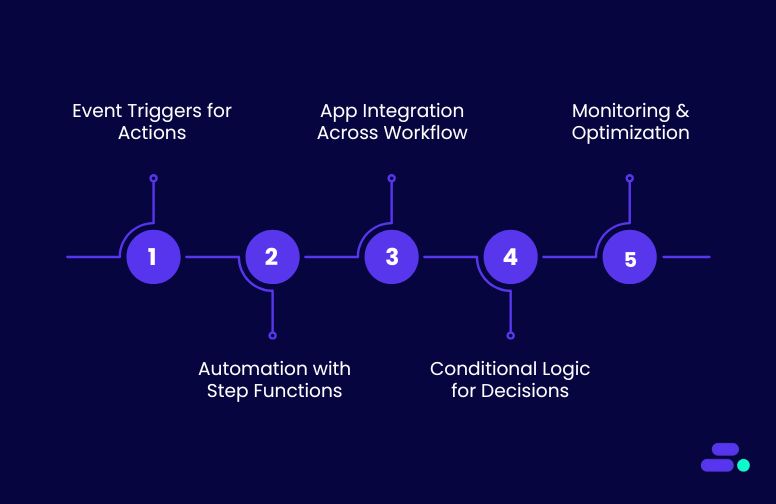
The lack of a structured approach to workflow orchestration means disconnected systems, repetitive manual tasks, and costly errors that slip through the cracks. Processes may work in isolation, but when growth hits or new tools are introduced, the patchwork begins to fray, slowing teams down and making operations harder to manage.
With the right orchestration strategy, every task is part of a coordinated system. Work moves from one step to the next without bottlenecks or missed handoffs.
AWS makes this possible by combining event-driven automation, integration across diverse applications, and built-in intelligence for handling exceptions. For SMBs, this shift transforms workflows from a series of manual checklists into a reliable engine for productivity and growth, and the following techniques outline exactly how to put that engine to work.
Technique 1: Event-driven triggers for teal-time actions
In traditional SMB operations, processes might rely on scheduled checks or manual intervention. Someone runs a report every few hours, a batch script updates records overnight, or staff manually verify data before moving to the next step. This creates delays, increases error risk, and slows down the entire workflow.
AWS flips this model with event-driven triggers, where actions happen the moment a relevant event occurs.
How this technique brings efficiency:
- Instant responsiveness: Amazon EventBridge captures events the second they occur (e.g., order creation, file upload, form submission) and routes them to the right process without human involvement.
- Seamless integration: Works across AWS services and external SaaS tools, connecting sales, operations, and customer systems into a unified, responsive network.
- Error reduction: Real-time triggers eliminate the lag and manual handling that often lead to duplicated tasks, missed updates, or outdated information.
Use Case: From manual lag to instant fulfillment
Before applying technique: A small online retailer receives orders through their e-commerce platform. Staff export order data to spreadsheets every few hours, manually verify payments, update inventory in a separate system, and finally send the order to the warehouse. If multiple orders come in between updates, stock levels can be inaccurate, and fulfillment may be delayed.
After applying technique: As soon as a customer places an order, AWS EventBridge detects the event from the e-commerce system. It triggers an AWS Step Functions workflow, which calls an AWS Lambda function to verify payment through the payment gateway. If payment is approved, another Lambda function updates stock levels in the inventory database and sends a fulfillment request to the warehouse system via an API.
The customer instantly receives a confirmation email through Amazon Simple Email Service (SES). No waiting for batch updates, no manual checks, just an automated, accurate, and immediate process from click to confirmation.
Technique 2: Step-by-step process automation with AWS Step Functions
Complex workflows often rely on multiple people, systems, and emails to move forward. A missed email, a failed file upload, or a miscommunication can stall progress for hours or even days. Each step depends on someone confirming that the previous one is done, creating bottlenecks and risking errors.
AWS Step Functions changes this by orchestrating workflows as clearly defined, automated steps, each dependent on the successful completion of the previous one, with built-in error handling and retries.
How this technique brings efficiency:
- Clear, structured flow: Breaks complex processes into distinct, manageable steps that execute in a precise sequence.
- Built-in reliability: Automatically retries failed steps and manages exceptions, ensuring workflows don’t stop due to temporary issues.
- Cross-service orchestration: Connects AWS services, APIs, and even external systems into one cohesive automated process.
Use Case: From scattered onboarding tasks to one seamless flow
Before applying technique: A small manufacturing SMB onboards new vendors through a patchwork process. It includes emailing for documents, manually verifying compliance, creating accounts in the ERP system, and sending bank details to finance for payment setup. Each step is tracked in spreadsheets, requiring multiple follow-ups and risking missed or inconsistent data.
After applying technique: AWS Step Functions coordinates the entire onboarding sequence. When a new vendor signs up, the workflow starts automatically: an AWS Lambda function verifies submitted documents, another function integrates with the ERP API to create the vendor account, and a third securely sends payment details to finance.
If any step fails, say, a document is missing, AWS Step Functions pauses the process, sends an Amazon SNS notification to the responsible team, and resumes once resolved. Every stage is tracked automatically, ensuring vendors are onboarded quickly, consistently, and without back-and-forth delays.
Technique 3: Integrating multiple applications across the workflow
In some SMBs, operations span multiple tools, like an e-commerce platform for sales, a shipping provider’s portal for deliveries, a CRM for customer data, and an accounting system for finances. Without integration, staff spend hours copying data from one system to another, risking typos, delays, and mismatched records. This manual effort not only slows things down but also creates blind spots when teams rely on outdated or incomplete information.
AWS workflow orchestration solves this by acting as the “translator” between systems. Using AWS Lambda functions, APIs, and services like Amazon EventBridge, data can move fluidly across platforms without manual intervention. This jeeps every tool in sync in near real time.
How this technique brings efficiency:
- Unified data flow: Ensures all connected systems reflect the same, up-to-date information.
- Fewer manual steps: Eliminates repetitive data entry, freeing staff to focus on higher-value work.
- Scalable connections: Works with both modern cloud tools and older legacy systems via APIs or middleware.
Use Case: From disconnected systems to a unified order pipeline
Before applying technique: A small specialty foods retailer manages online orders in their e-commerce site, manually updates stock in a local database, books shipments through a courier’s portal, and then sends weekly sales summaries to their accountant. Each step requires logging into different systems and copying data by hand, leading to mistakes and delays.
After applying technique: When an order is placed, Amazon EventBridge detects the event and triggers a Step Functions workflow. An AWS Lambda function updates the inventory database instantly, another books a shipment with the courier via their API, and a third sends order and payment details to the accounting system.
This happens within seconds, so inventory levels, delivery status, and financial records are always current, without a single spreadsheet or manual copy-paste.

Technique 4: Conditional logic for smarter decisions
In many SMB operations, decisions are still made by someone manually reviewing data, like approving an order, escalating an issue, or flagging a payment problem. This not only slows the process but also introduces inconsistency, as different people may follow slightly different rules.
AWS Step Functions changes this with choice states, enabling workflows to automatically take different paths based on real-time inputs. Instead of every request following the same route, the system can “think” in logic branches. This checks conditions, applying business rules, and routing tasks without human intervention.
How this technique brings efficiency:
- Automated decision-making: Eliminates delays caused by waiting for manual reviews.
- Consistency and compliance: Every decision follows the same rules and thresholds.
- Reduced operational load: Staff only step in for true exceptions or complex cases.
Use Case: From manual reviews to automated, rules-driven actions
Before applying technique: A small subscription-based software company processes customer payments once a month. If a payment fails, the finance team manually retries the transaction, sends a follow-up email, and flags the account for possible suspension. This requires staff attention multiple times a week.
After applying technique: An AWS Step Functions workflow runs as soon as the billing system detects a failed payment. Using a choice state, it retries the payment up to three times via an AWS Lambda integration with the payment gateway. If the third attempt fails, the workflow automatically sends an alert to customer support through Amazon SNS, while also notifying the customer via Amazon SES.
Finance only gets involved for unresolved cases. This frees their time while ensuring no failed payment slips through the cracks.
Technique 5: Built-in monitoring and optimization
Workflows are a “black box” for many businesses. Once a task starts, there’s little visibility until it’s complete. This makes it hard to spot bottlenecks, diagnose errors, or know where improvements can save time or money.
AWS workflow orchestration changes that with built-in monitoring and analytics. Tools like AWS Step Functions’ execution history, Amazon CloudWatch metrics, and AWS X-Ray tracing provide real-time and historical insights into how workflows run, where failures occur, and which steps consume the most resources. This data-driven visibility allows SMBs to refine workflows with confidence instead of relying on trial and error.
How this technique brings efficiency:
- Proactive issue detection: Spot errors or delays before they affect customers.
- Data-backed optimization: Adjust workflows for cost, speed, and reliability.
- Continuous improvement: Make iterative changes based on actual usage trends.
Use Case: From reactive troubleshooting to proactive refinement
Before applying technique: A small legal services firm relies on a manual review process for client document verification. If delays occur, they’re only noticed after customers complain. Staff investigate manually, often wasting hours retracing steps.
After applying technique: With Step Functions logging each state’s execution time and CloudWatch tracking performance metrics, the team sees that the document verification Lambda consistently takes the longest. They replace it with an AWS Textract-powered OCR workflow, cutting average processing time by 40%. Bottlenecks are now identified in minutes, not days, keeping client satisfaction high and costs in check.

Even if workflow automation feels like a daunting project for SMBs, Cloudtech makes it achievable. Its AWS experts create orchestration strategies that are business-ready on launch day, delivering efficiency, accuracy, and scalability right from the start.
How does Cloudtech make AWS workflow orchestration work for SMBs?
Modern SMBs juggle multiple tools, teams, and processes, and when those aren’t connected, efficiency takes the hit. AWS workflow orchestration changes that by linking systems, automating tasks, and keeping every step running in sync. Cloudtech, as an AWS Advanced Tier Services Partner built exclusively for SMBs, ensures this transformation is done right from the start.
Instead of piecemeal automation, Cloudtech builds cohesive, cloud-native workflows that are easy to scale and maintain. Here’s what that looks like:
- Tailored to SMB realities: From design to monitoring, Cloudtech delivers orchestration strategies that fit lean teams, cutting out complexity and high overhead.
- Resilient by design: Fault-tolerant states, smart retries, and seamless failovers keep processes running, even when a single step encounters trouble.
- Performance-aware automation: Using AWS Step Functions, EventBridge, and Lambda, workflows are tuned to run faster, cost less, and eliminate redundant work.
- Empowered teams: Training, clear documentation, and best-practice guides mean SMBs can confidently adapt and grow their workflows over time.
With Cloudtech, workflows become a dependable, intelligent backbone for business growth.
See how other SMBs have modernized, scaled, and thrived with Cloudtech’s support →

Wrapping up
Efficient workflow orchestration lets SMBs run faster, reduce errors, and adapt quickly without piling on manual effort or disconnected tools. But the real magic isn’t in simply automating tasks. It’s in designing workflows that evolve alongside the business, handle exceptions gracefully, and optimize every moving part.
With Cloudtech’s deep AWS expertise, a focus on reliability, and a hands-on approach, SMBs can build orchestration solutions that are seamless from day one and scalable for years to come. When workflows run smoothly and intelligently, teams can spend less time firefighting and more time innovating, serving customers, and seizing opportunities.
Ready to streamline your operations? Get on a call with Cloudtech and discover how AWS workflow orchestration can become your SMB’s growth engine.
FAQs
1. What is AWS workflow orchestration?
AWS workflow orchestration is the process of coordinating multiple tasks, services, and applications so they work together seamlessly. Using tools like AWS Step Functions and Amazon EventBridge, SMBs can automate repetitive processes, handle decision logic, and integrate cloud and on-prem systems without manual intervention.
2. Why should SMBs care about workflow orchestration?
For SMBs, time and resources are often limited. Orchestration eliminates manual hand-offs, reduces human error, and ensures that business processes from order fulfillment to approvals run faster and more reliably. This leads to higher productivity, happier customers, and better use of IT budgets.
3. How does AWS Step Functions help in orchestration?
AWS Step Functions lets businesses design workflows as state machines, breaking complex processes into manageable steps with built-in retries, error handling, and conditional paths. It can integrate with over 200 AWS services and external APIs, making it ideal for unifying systems in a growing SMB environment.
4. Can workflow orchestration handle both cloud and legacy systems?
Yes. With AWS Lambda functions, API Gateway, and connectors, orchestration can bridge modern SaaS apps, AWS services, and even on-premise legacy systems, allowing data to flow smoothly between them without duplication or mismatches.
5. How can Cloudtech help SMBs get started with AWS workflow orchestration?
Cloudtech designs, builds, and manages tailored orchestration solutions for SMBs. From identifying automation opportunities to implementing AWS best practices and providing ongoing support, Cloudtech ensures workflows are reliable, scalable, and aligned with business goals from day one.

Get started on your cloud modernization journey today!
Let Cloudtech build a modern AWS infrastructure that’s right for your business.

